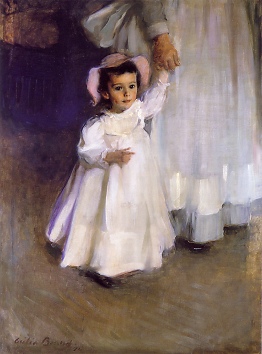In this column you'll see a variety of topics
addressed, some philosophical, some aesthetic and some practical.
As we go forward, we welcome your comments and questions, as
well as your thoughts on particular topics you'd like to see
addressed.
Portfolio Elements
| |

Ernesta (Child with Nurse), 1894
By Cecilia Beaux
Metropolitan Museum of
Art |
Next to your original portraits, your portfolio will be your
most important marketing tool. It is the key place you will
show your very best portraits, demonstrating the diversity
of sizes, subjects and compositions you offer for commissioned
work.
You may already have found that many of your non-artist clients
(that would be most, if not all, of your clients) can be very
literal in their ability to envision, for example, a three-quarter
painting of a five year old redhead girl by viewing a head/shoulders
image of a teenage dark-haired boy. Part of your job is to
help make your client's visualization easy.
Like the original portraits you create as samples, you will
want your ideal portfolio to include at least one of each
of the sizes and media you offer for sale. If you offer a
head/shoulders, half figure, three-quarters, and/or full length,
your goal is to have at least one portfolio image of each.
It's not necessary to have one each of every medium in which
you work—you might have a one charcoal head/shoulders,
one oil half figure, etc.
Likewise it's important to vary your subjects by several
criteria, including age, gender, ethnicity, setting, degree
of formality—e.g., family /corporate—or any other
way that mirrors the client base you wish to target, and importantly,
the type of portraits you want to paint. Tailor your criteria
to reflect your local market first. For example, it will be
more important to include Asian subjects if you live in San
Francisco than if you live in Atlanta. Likewise, it's more
important to include Hispanic clients if you live in Arizona
than if you live in Hew Hampshire.
But more important than anything else is quality. Only your
very best work goes into your portfolio. Begin your portfolio
with 8-10 of your best pieces. Don't be tempted to put in
older, less accomplished work simply because it might fulfill
another criterion. As Peggy Baumgaertner has said, "You
will be judged by the weakest portrait in your portfolio."
Each time you paint a new portrait that is better that your
initial set of images, add it—and remove the weakest
image.
When you are starting your portrait practice, it's unrealistic
to think that you can just go into your archived images and
find your blond toddler boy, your 8 -year old brunette girl,
your grandparent double portrait, your corporate suit, and
so forth. You'll have to paint for your portfolio. If you
are busy with your commission work (or any other kind of work),
plan and schedule portraits of models who will fill in your
criteria gaps. Paint each one as if it was the most important
painting of your life (which, incidentally, should be your
attitude every time you paint a portrait, paying or not).
Putting your portfolio together
Now that you have selected the images to include in your portfolio,
you'll have to figure out how to get them printed. That means
several things:
- High quality paper, consistent in finish and color
- Excellent color accuracy
- Consistent photo sizes
If you have some skill in Photoshop or other image manipulation
computer programs, you can do your own printing. If you want
someone else to make your prints, you'll need to be sure that
you provide an excellent print to which his or her prints can
be matched. If you'll be ordering in quantity, you will need
to personally view a match print to check it for accuracy and
quality.
There are some computer color calibration programs that can
create a universally accurate color descriptor in your computer—I
haven't yet found one that is very user friendly, but you
might have better luck. Work with whomever will be doing your
printing to find out how to get the very best matching information
to him or her. Using a color bar when you photograph your
work will save you many headaches later on.
Now that you have such beautiful prints of your beautiful
paintings, you'll need to decide what else goes into your
portfolio. Different artists will have diverse opinions, but
to make the presentation hold together you will want some
kind of title or cover sheet, usually with your name and contact
information. And, oh! What an excellent opportunity to utilize
your carefully considered business identity!
You may also wish to include a short bio, resume or artist's
statement. I like to keep an updated fee schedule and place
it as the last item in my portfolio.
That's a lot of stuff. But it doesn't have to be done all
at once, and it doesn't even have to be done at all before
you begin to show clients what you can do, and accepting commissions.
Just work on developing your portfolio as you go along, and
as you paint more and better work.
See you next time,

Copyright © 2006 by Chris
Saper.
Chris Saper has painted commissioned portraits for fifteen
years, following a seventeen-year career as a health care executive
in Phoenix, Arizona. In addition to her painting schedule, she
is an active portrait instructor, teaching both portrait painting
and business skills. Chris is the author of Painting Beautiful
Skin Tones with Color and Light. |